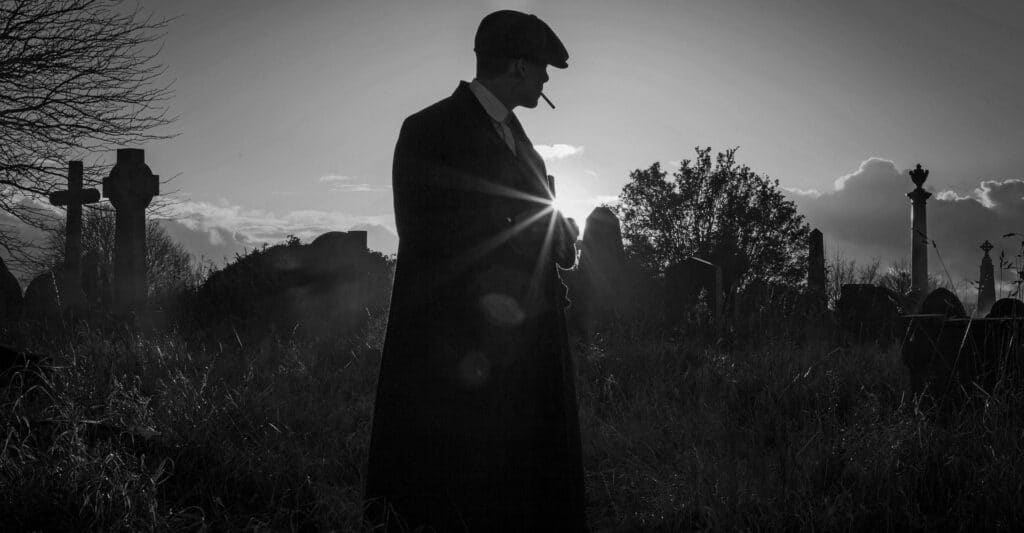
To do an impression of Thomas Shelby from Peaky Blinders you’ll have to speak slowly whispering from the back of the throat and add a lot of gravel. Learning Brummie accent, keeping your voice monotone, utilizing diaphragmatic breathing and proximity effect will make your Thomas Shelby impression perfect.
Whisper
Thomas Shelby speaks almost in a whisper which makes his voice sound significantly lower than when speaking normally. Naturally, when we speak in a hushed voice the vocal cords move less frequently making the voice much deeper. Also, it makes you sound more authoritative and certain which is why we like the Thomas Shelby voice so much.
When attempting the Thomas Shelby impression aim to hush down your voice almost to a whisper and you should be set.
Speak slowly
Similar to whispering, speaking slowly adds depth to your voice and makes you sound more confident and unfazed just like Thomas Shelby. You’ll also have more time to breathe when speaking slowly which allows applying various voice techniques with more ease.
Speak from the back of the throat
Thomas Shelby speaks in a very low voice. To do his impression, you’ll have to speak from the back of the throat. You can help yourself by placing a hand on your Adam’s apple. When speaking with a deeper voice your Adam’s apple ought to go down a bit. Most importantly you should feel resonance at the back of your throat. Also, after a while of doing the voice impression, you’ll start feeling irritation in your throat, that’s how you know you’re doing good.
Use growling voice
Thomas Shelby has a lot of gravel in his voice. To add some gravel or growl to your voice start making the ‘ahhhh’ sound with some crackling and popping in it, like in an example below. Now integrate this growling sound with a low, throaty, whispering voice and you should get a feel of how Thomas Shelby talks. The example is overdoing it a bit, you’ll have to tune it to fit the voice.
Use monotone voice
When doing the Thomas Shelby impression keep your voice monotone. Notice how he’s mostly calm and speaks slowly despite the havoc around him. His voice and pitch don’t change much, which makes him the scary character that he is.
Birmingham Accent
Peaky Blinders characters are from Birmingham and Thomas Shelby has a very thick Brummie accent. You’ll have to learn it to do the impression.
Here are some guidelines on how you can achieve a Brummie accent:
- Emphasize ‘u’ letter, it should sound more like ‘uh’
- ‘Oh’ sound is pronounced as ‘ow’.
- Emphasize on letter ‘i’ in words such as it, in, is, etc.
- ‘A’ letter is often pronounced as ‘I-E’. So words such as ‘Tame’ sound more like ‘Ti-eme’
- ‘Y’ at the end of words is emphasized and sounds more like ‘ey’
- ‘R’ isn’t pronounced after vowels.
- ‘R’ pronounced before vowels is elongated and rolled
- Often in Birmingham, words are linked together and it’s hard to distinguish a separate word in a sentence.
- Drop the ‘H’ letter
- ‘T’ letter is articulated softly and breathy
- The tone goes down at the end of the sentences
Alternatively, watch the video below for more explanation.
Use the diaphragm for breathing
Doing a voice impression puts a lot of strain on your voice and requires lots of air. Learning to breathe using the diaphragm will help you to maintain the Thomas Shelby voice impression and will give you more air to work with. For example, if you plan on shouting in Thomas Shelby’s voice, you’ll require lots of air and using a diaphragm is essential.
When breathing using the diaphragm your lungs and shoulders shouldn’t rise much. You can learn how to strengthen diaphragmatic muscles in this article.
Speak close to the microphone
Finally, if your Thomas Shelby impression involves a microphone then you can utilize the proximity effect which makes your voice sound deeper. In Peaky Blinders, you can hear that Thomas Shelby is speaking very close to the microphone which adds more depth and intimacy to his voice, it sounds very close to the ear.
In order to add more depth, you can also get very close to the microphone and it’ll make your voice significantly deeper and more intimate.

Thank you so much🙃